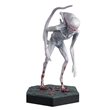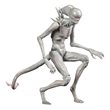Alien: Covenant - David’s Drawings: Dissections of a Cosmic God Complex
Over the years, I’ve built up quite a library of art books from various movies. Usually, these glossy coffee table books contain photos of concept art, production models, and set environments. Alien: Covenant – David’s Drawings, which was published by Titan Books last year, looks and feels like one of these art books. However, it is so much more: It’s both a crucial component of the Alien: Covenant story and a significant addition to the Alien saga as a whole.
David’s Drawings is actually two books in a single set: a hardback book that contains the sketches, and Alien: Covenant – Developing the Art of an Android, a softcover book that features an interview with artists Matt Hatton and Dane Hallett. Hatton and Hallett were brought in to Covenant by director Ridley Scott to create the drawings that were seen in the living space of the android David (Michael Fassbender).
Some of the drawings can also be seen in The Art and Making of Alien: Covenant book by Simon Ward and in The Creatures of Alien: Covenant booklet that was included in one of the Blu-ray editions of Covenant. What makes David’s Drawings different is that the illustrations are arranged to give the reader a sequential look into David’s examinations of the Engineers and their home world, his early attempts at creating Xenomorphs, and what he did (or might have done) to the body of Dr. Elizabeth Shaw (Noomi Rapace). Many of the illustrations include notes from David, notes that range from the identification of specific anatomical details to his thoughts about the Engineers and the Xenomorphs. Even though these sketches were created as props for the movie, they tell a compelling and creepy story of their own that’s important to understanding David, the Engineers, and the Xenomorph.
I recommend that fans read Developing the Art of an Android before looking at the drawings, because it details how Hatton and Hallett approached the sketches based on their own ideas and the directions they received from Scott. It delves into how their illustrations fused together the styles of H.R. Giger, Leonardo DaVinci and Rembrandt, and how the two artists were able to produce artwork that appeared to come from the same character. Hatton and Hallett’s most amusing and interesting anecdotes recount how Scott and the Covenant production crew reacted to their artwork (some remarked, “Those guys are sick!”) and how they thought David felt about Shaw (something akin to how “a serial killer might ‘love’ a victim.”).
The drawings tantalizingly hint at a number of ghastly things that weren’t seen in Covenant. In fact, a few of the illustrations suggest that David’s genocide of the Engineers involved many more unthinkable atrocities than just his deployment of a bioweapon on the Engineers’ capital city. Some of the sketches of David’s early Xenomorph creations bear noticeable similarities to Giger’s concept art for both Alien and Alien 3, as well as the horribly malformed Ellen Ripley clones and the Newborn hybrid from Alien: Resurrection. Knowing where the Alien saga goes in the subsequent four movies, David’s Drawings has a past-is-prologue feel to it that fans of the franchise will relish.
Fans frequently associate the Alien franchise with the Predator franchise, largely due to the many Aliens vs. Predator titles and merchandise. Based on what I’ve seen, I think that the Alien prequels Prometheus and Covenant are Ridley Scott’s refutation of that pairing, arguing instead that the Alien saga’s true cinematic soul mates are the Blade Runner movies. I discussed this briefly in my previous analysis of Covenant, and David’s Drawings reinforces this connection significantly. Both the Alien and Blade Runner series use the subjects of space travel, terraforming and genetic manipulation to explore the concepts of sex, death, creation and extinction. David’s Drawings take that feature and peel it back, layer by layer through skin, muscles and bones, to provide fans with explicit views of the cosmic horrors that emerge when a god complex see its destiny among the stars.
Related Products:









Comments
Post a Comment